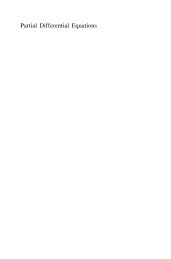a Matlab package for phased array beam shape inspection
a Matlab package for phased array beam shape inspection
a Matlab package for phased array beam shape inspection
Create successful ePaper yourself
Turn your PDF publications into a flip-book with our unique Google optimized e-Paper software.
28 6 JITTER CALCULATIONS<br />
direction would be if the start time error would vary systematically across the <strong>array</strong>, say<br />
increase with a constant step from element to element.<br />
It is possible to imagine the DDS start timing to be implemented in such a way that<br />
systematic start time gradient would occur naturally. For instance, if we were using<br />
a trigger that spreads from the origin across the <strong>array</strong>. Or if we were having a part<br />
DDS, part analog up-conversion to RF, the analog LOs, even though obviously being<br />
phase-locked, could still have a systematically increasing initial phase across the <strong>array</strong>.<br />
To be avoided.<br />
Instead, all the DDSs should (conceptually) have their own clock, which starts the<br />
DDS using only in<strong>for</strong>mation that is independent of the pointing direction. Say, starts<br />
after a hardwired, calibrated-once, element-depending, delay after receiving a centrally<br />
generated trigger pulse. Or starts directly based on some pre-programmed instant of<br />
time at the element’s local clock.<br />
Even small random timing errors will to some degree resemble an overall phasing<br />
gradient, and thus change the <strong>beam</strong> direction. And even if not changing the <strong>beam</strong><br />
direction, the timing jitter would cause incoherence to the <strong>array</strong>’s radiation, and this<br />
would reduce the available level of constructive interference that is the basic of the<br />
<strong>beam</strong>-<strong>for</strong>ming, and thus would reduce the maximum available gain. Simulation seems to<br />
indicate that the actual required timing accuracy is not anywhere near the 8 ps. Rather,<br />
it appears that someting like 100 ps would already be enough.<br />
6. Jitter calculations<br />
6.1. Method<br />
To allow both amplitude and phase jitter at the antenna elements, we write the <strong>array</strong><br />
factor as<br />
AF(u x , u y ) = | ∑ m x<br />
∑<br />
m y<br />
a mxm y<br />
e iψmxmy e i2πDx(ux−u0 x )mx e i2πDy(uy−u0 y )my | , (89)<br />
where u 0 x = δ x /2πD x and u 0 y = δ y /2πD y are the direction cosines of the phase-steered<br />
<strong>beam</strong>. The amplitudes a are taken to jitter around unity with a distribution that we<br />
will take to normal with variance ∆a<br />
a = 1 + N(0, ∆a). (90)<br />
The errors ψ of the steering phase steps δ x and δ y will be normally distributed around<br />
zeros with standard deviation ∆ψ<br />
ψ = N(0, ∆ψ). (91)<br />
Without any jitter, the maximum value of AF, the (relative) gain in direction (u 0 x, u 0 y),<br />
is equal to the number N = M x M y of <strong>array</strong> elements. The first observation is that, with<br />
only phase errors, but not amplitude errors,<br />
AF(u x , u y )
















